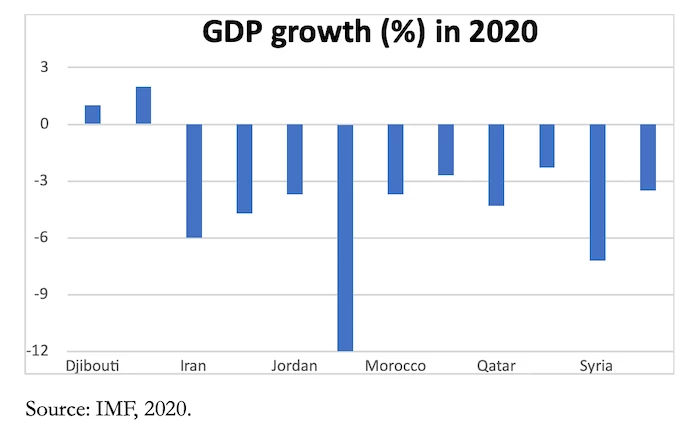 ومن الأهمية بمكان والمنطقة تتعافى من الركود الاقتصادي أن تراعي الحكومات في تعافيها الاقتصادي الاعتبارات البيئية.
ومن الأهمية بمكان والمنطقة تتعافى من الركود الاقتصادي أن تراعي الحكومات في تعافيها الاقتصادي الاعتبارات البيئية.
COVID-19 has caused a significant economic downturn in the Middle East and North Africa (MENA) region. According to IMF projections, the MENA region's economy is estimated to be contracting by about 3.3% in 2020, which is slightly worse than the world average that is forecast to be 3%. Within the MENA region there is also large regional disparity with national economic growth predictions ranging from +2.2% in Egypt to -12% in Lebanon (examples in the figure below). As the region recovers from the economic downturn, it is important that governments make their recovery 'green' (see our previous blog).
How could a green recovery plan for MENA look like?
We can look towards Europe. Europe was affected by the coronavirus early on, and intensely so, and so many countries reacted with tough lockdowns. Since then, many countries have re-opened, after encouragingly low COVID-19 case reproduction numbers. After the immediate relief phase, the continent had a choice on which recovery path it would chose. The continent stood at a cross-roads with significant voices wanting to scrap the region’s Green Deal. Fortunately, Europe decided to instead make the “European Green Deal the EU’s recovery strategy.” By the end of May 2020, the European Union announced its recovery plan for the post corona crisis for funds in the amount of Euro 750 billion (US$821 billion) to be provided under green conditions, focusing on land restoration, biodiversity, and lowering emissions in priority sectors among other strategies.
For MENA, there are certain sectors that should be priorities for 'going green,' such as transport and fuel. In the region, industries and traffic are the main contributors to emissions causing local air pollution (see Karagualian et al, 2015). Examples of globally tried-and-tested policies for such sectors include, mandating energy efficiency targets, energy efficiency standards for firms, fuel efficiency standards for vehicles, fuel switching, end-of-pipe technologies and pricing pollution/carbon (or removing perverse subsidies for pollution/carbon). In addition, energy efficiency standards for buildings, and minimum performance standards for appliances, such as air conditioners and refrigerators, hold high promise in MENA (see Ouedraogo 2020).
What could a green recovery plan look like for MENA?
There has been much discussion around finding shovel-ready projects to quickly support the economic recovery phase of the pandemic: projects that can hit the ground running and provide employment opportunities for many people. Two examples of such projects that are greening 'brown' activities include scaling up of successful pollution abatement projects, as well as launching of new projects, like the Egypt Environmental Pollution Abatement Project (EPAP), and the Air & Climate Pollution Reduction Project in Egypt. Moreover, another example from a current project that can add value to this important initiative is the Lebanon Environmental Pollution Abatement Project (LEPAP):
- The LEPAP has offered credit to firms heavy polluting industries with near 0% interest rates for a period of 7 years with a grace period of up to 2 years. LEPAP has provided this concessional funding to fuel switching, energy efficiency and end-of-pipe projects.
- The EPAP project helps industry improve performance and comply with environmental regulations. Eligible industries in Greater Cairo and Alexandria can take advantage of funds to borrow for fuel switching, energy efficiency, and end-of-pipe technologies at near zero interest rates. Scaling them up now would be the perfect opportunity for green recovery.
- The Air & Climate Pollution Reduction Project in Greater Cairo, Egypt, under preparation, aims to reduce pollution from the transport sector and the solid waste management sector, which are the two largest contributors to emissions in the Greater Cairo area.
Fiscal stimulus supporting green projects is particularly important for the MENA region , where most people depend on natural capital. Working towards an inclusive green stimulus means that low-cost financing will be made available for green activities, and that benefits from these investments accrue in particular to lower income groups. Even though most of MENA’s population lives in urban areas (60%), most of MENA’s poor live in rural areas. Egypt, Yemen, Tunisia, and Morocco for instance, all have more poor people living in rural areas than they do in urban areas. It has been found that "greening" was significantly related to poverty reduction, and moreover, that "greening" was pro-poor, meaning that it benefitted disproportionately poorer communities (see Heger et al, 2020).
There are examples of sustainable land management practice investments, such as the promising project of the Tunisian Oases Ecosystems and Livelihoods Project, which helped traditional oases to fend off the relentless forces of desertification. This project also provided opportunities and jobs for many young people and improved the output from this ecosystems, producing dates, jam, honey and ecotourism, and thus increasing the income of rural communities.
Another example of high-return green investments is the Integrated Land Management in Lagging Regions project in Tunisia, which included climate-smart land management interventions that are crucial during particularly hot years. Integrated land management interventions are not only key climate change adaptation strategies, but they also contribute significantly to greenhouse gas mitigation.
And finally, there are also crucial opportunities for coastal management and creating a sustainable Blue Economy. In addition to improving inclusiveness on land, so are there win-win-win-win opportunities on the shores of the sea, and in the sea. For example, the Integrated Coastal Zone Management (ICZM) program in Morocco helped boost incomes of low-income coastal communities by supporting their livelihoods with alternative activities.
Fisherfolk’s livelihoods were successfully diversified in order to make them more resilient to global warming and ensuing warming of the oceans. For example, temperature-sensitive fish stock that are negatively affected by increases in temperatures have negative impacts on the sustenance of coastal communities and consumption. Supporting additional activities such as algae culture and eco-tourism helps communities to diversify and become more resilient to climate shocks. Healthy coastal and marine ecosystems are a safety net and can be a motor for growth and development for many countries in the MENA region with diverse and productive coastlines as well as a long history of interdependence with the ocean.




Join the Conversation